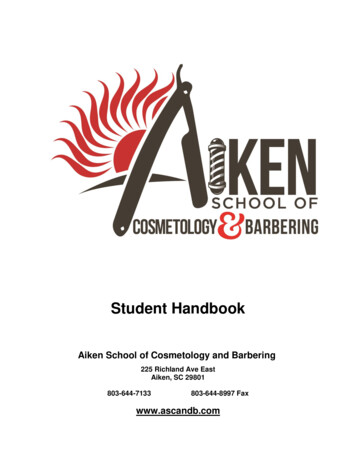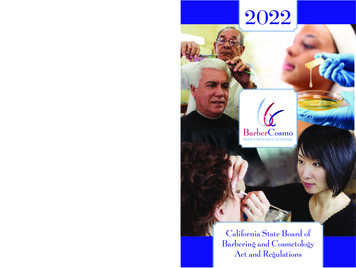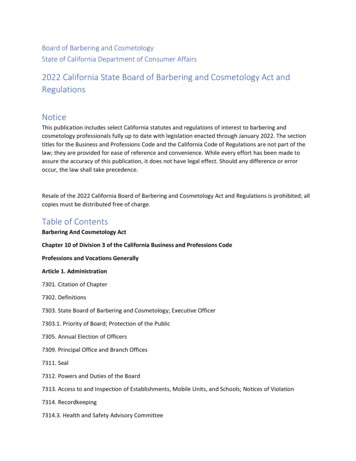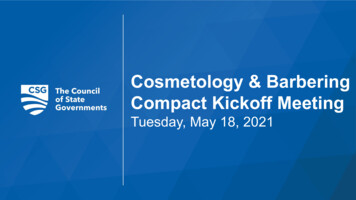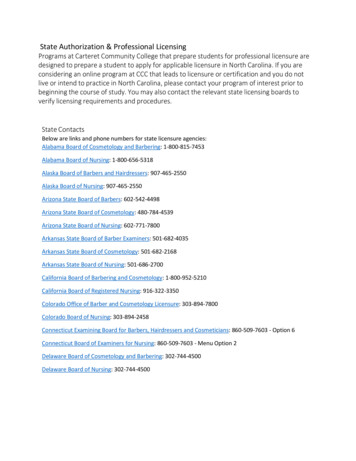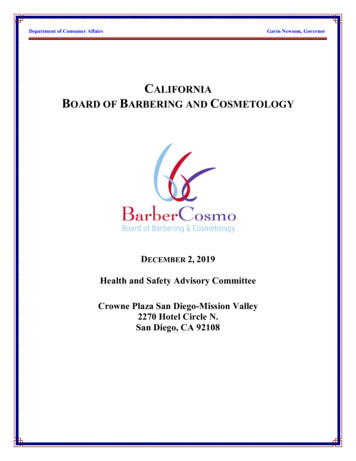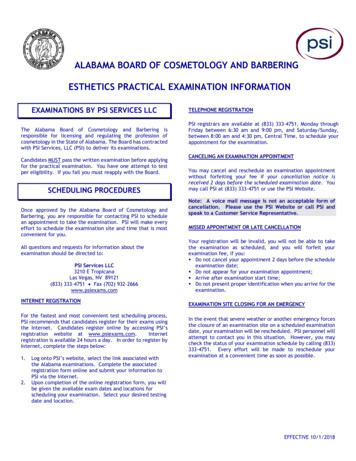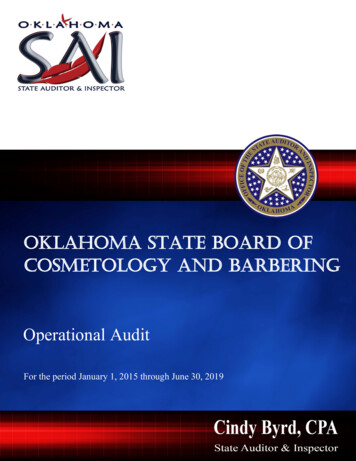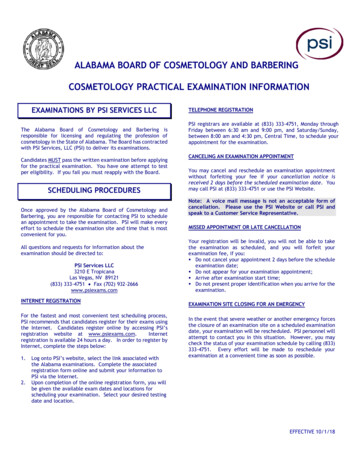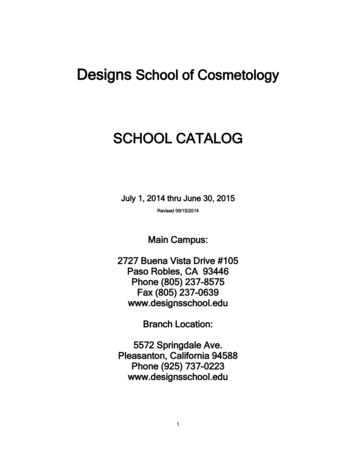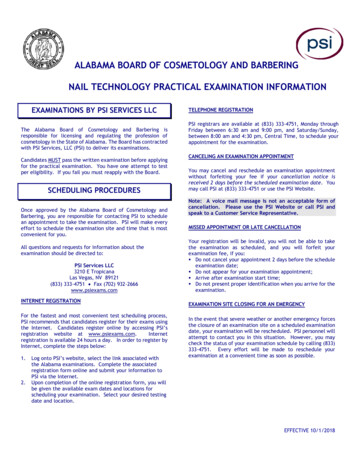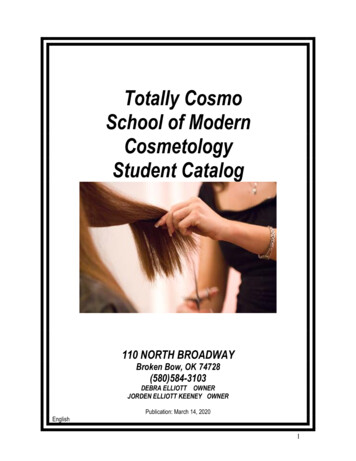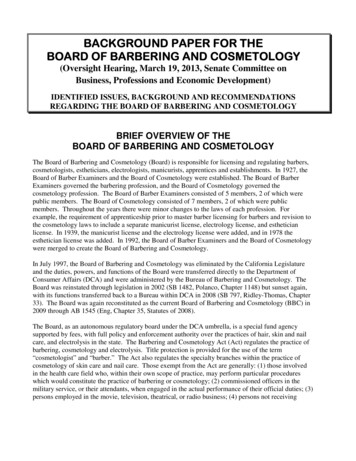
Transcription
BACKGROUND PAPER FOR THEBOARD OF BARBERING AND COSMETOLOGY(Oversight Hearing, March 19, 2013, Senate Committee onBusiness, Professions and Economic Development)IDENTIFIED ISSUES, BACKGROUND AND RECOMMENDATIONSREGARDING THE BOARD OF BARBERING AND COSMETOLOGYBRIEF OVERVIEW OF THEBOARD OF BARBERING AND COSMETOLOGYThe Board of Barbering and Cosmetology (Board) is responsible for licensing and regulating barbers,cosmetologists, estheticians, electrologists, manicurists, apprentices and establishments. In 1927, theBoard of Barber Examiners and the Board of Cosmetology were established. The Board of BarberExaminers governed the barbering profession, and the Board of Cosmetology governed thecosmetology profession. The Board of Barber Examiners consisted of 5 members, 2 of which werepublic members. The Board of Cosmetology consisted of 7 members, 2 of which were publicmembers. Throughout the years there were minor changes to the laws of each profession. Forexample, the requirement of apprenticeship prior to master barber licensing for barbers and revision tothe cosmetology laws to include a separate manicurist license, electrology license, and estheticianlicense. In 1939, the manicurist license and the electrology license were added, and in 1978 theesthetician license was added. In 1992, the Board of Barber Examiners and the Board of Cosmetologywere merged to create the Board of Barbering and Cosmetology.In July 1997, the Board of Barbering and Cosmetology was eliminated by the California Legislatureand the duties, powers, and functions of the Board were transferred directly to the Department ofConsumer Affairs (DCA) and were administered by the Bureau of Barbering and Cosmetology. TheBoard was reinstated through legislation in 2002 (SB 1482, Polanco, Chapter 1148) but sunset again,with its functions transferred back to a Bureau within DCA in 2008 (SB 797, Ridley-Thomas, Chapter33). The Board was again reconstituted as the current Board of Barbering and Cosmetology (BBC) in2009 through AB 1545 (Eng, Chapter 35, Statutes of 2008).The Board, as an autonomous regulatory board under the DCA umbrella, is a special fund agencysupported by fees, with full policy and enforcement authority over the practices of hair, skin and nailcare, and electrolysis in the state. The Barbering and Cosmetology Act (Act) regulates the practice ofbarbering, cosmetology and electrolysis. Title protection is provided for the use of the term“cosmetologist” and “barber.” The Act also regulates the specialty branches within the practice ofcosmetology of skin care and nail care. Those exempt from the Act are generally: (1) those involvedin the health care field who, within their own scope of practice, may perform particular procedureswhich would constitute the practice of barbering or cosmetology; (2) commissioned officers in themilitary service, or their attendants, when engaged in the actual performance of their official duties; (3)persons employed in the movie, television, theatrical, or radio business; (4) persons not receiving
compensation and done outside of a licensed establishment; (5) persons who are demonstrating,recommending or selling hair, skin or nail products; (6) students performing services on the publicwhile enrolled in an approved school.The current Board mission statement, as adopted in October 2012 as part of the Board’s strategic plan,is as follows:To ensure the health and safety of California consumers by promotingethical standards and by enforcing the laws of the beauty industry. The Board protects theinterests of California consumers by: Serving as a guardian of their health and safety;Enhancing public and industry participation in decision-making; Promoting ethical andprofessional standards; and creating policies that are contemporary, relevant and responsive.The Board receives and processes an average of 40,656 applications for licensure as a barber,cosmetologist, manicurist, esthetician, electrologist and apprentice annually. On an average, the Boardalso receives an additional 6,198 applications annually for establishment of licenses.The Board ensures that applicants for licensure have completed the necessary training and passed thewritten and practical (hands on) components of the examination. The examination requires that theindividual demonstrate that they possess the knowledge and skills required to perform within the scopeof their discipline while protecting the public’s health and safety. After successfully passing theexamination, individuals are issued a license on the same day of the exam. The Board administers anaverage of 27,592 practical examinations and 32,111 written examinations.The Board states that it is committed to ensuring that consumers are protected when they receiveservices from barbers, cosmetologists, manicurists, electrologists, estheticians, apprentices and theestablishments in which they perform their services and does this through its licensing and examinationprogram, its enforcement program, inspections and an education and outreach program.The Board is comprised of nine members: five public and four professional members. The SenateCommittee on Rules and the Speaker of the Assembly each appoint one public member. The other 7members (4 public members and 3 professional members) are appointed by the Governor. As ofMarch 1, 2013 three current Governor-appointed members’ terms will expire. The Board elects apresident and vice-president, annually, who each serve a one-year term and can serve for a total of twoyears. The Board meets quarterly and rotates meeting locations between northern and southernCalifornia. All Board meetings are subject to the Bagley-Keene Open Meetings Act.Name and Short BioJoseph Federico, PresidentMr. Federico has been the chief financial officer of theFederico Beauty Institute since 2009, where he wasdirector of financial aid from 2006 to 2009 and hasserved on the board of directors since 2004. Mr.Federico has been a member of the AmericanAssociation of Cosmetology Schools and the CaliforniaAssociation of Student Financial Aid Administratorssince 1/01/2015AppointingAuthorityGovernorProfessionalor PublicProfessional
Wen Ling Cheng, Vice PresidentMs. Cheng has been a State Farm insurance agent since2001. Ms. Cheng is a long-time Bay Area resident whois involved in community service and is passionate aboutpromoting equal education opportunities.Bobbie AndersonMs. Anderson served as a field representative forAssemblyman Mike Davis from 2006 to 2009. She alsoworked as a supervising legal office assistant at the LosAngeles County Office of the Public Defender from1978 to 2003, and as a typist clerk for the Los AngelesCounty Department of Public Social Services from 1957to 1968. Ms. Anderson served on the executive board ofthe Legacy Service Employees International UnionLocal 660/721 from 1995 to 2003.Deedee CrossettMs. Crossett is the president and founder of the SanFrancisco Institute of Esthetics and Cosmetology(SFIEC). A graduate of Washington State University,with a bachelor's of arts degree in communications, Ms.Crossett spent approximately eight years working inmarketing and sales promotions for various companiesbefore moving into a field that she had always felt drawnto: the beauty industry. Ms. Crossett obtained heresthetics license in 2001, and worked as an esthetician,spa consultant, and esthetics trainer before openingSFIEC in 2002.Katie DawsonMs. Dawson has been the principal of Dawson DentalHygiene Practice since 2009. She was a dental hygienistfor Dr. Damani Mitchell from 2001 to 2009, Dr. JamesSweeney from 1995 to 2002, and Dr. Michael Hine from1991 to 2002.Richard HedgesMr. Hedges is the owner and director of CommunityHorizons. Mr. Hedges was educated as a teacher inKansas.He received his undergraduate degree inEnglish and History at Kansas State University, andearned his Master’s degree in American Urban Historyat San Francisco State University. Mr. Hedges wasemployed as a union representative for 28 years by theUnited Food & Commercial Workers InternationalUnion.Frank LloydMr. Lloyd is a licensed tax preparer, real estate broker,and general contractor. Previously, Mr. Lloyd was ateacher at Chaffey Community College, where hedeveloped the curriculum for real estate license renewalthrough the college. Mr. Lloyd is also a past member ofthe Commission on Aging.Christie Truc Tran, Board PresidentMs. Tranhas owned and managed Happy Nails of CostaMesa since 2005. Previously, she was manager ofHappy Nails of Newport Coast from 2002 to 2005.From 2001 to 2002, Ms. Tran was a nail technician atHappy Nails of Rancho Santa Margarita and a travelagent at Travel World from 1990 to 2001.05/02/201101/01/2015Speaker ate blic01/02/201101/01/2015GovernorProfessional3
01/12/2010Vacant01/01/2013GovernorProfessionalThe Board is a special fund agency supported by fees. The Board has two primary sources of revenue:license renewal fees and administrative fines. The Board has a continuous renewal cycle for all of itslicense categories with one exception, the apprenticeship license, which is not renewable. The renewalcycle is biennial and expires at midnight on the last day of the month of issuance. A license that hasexpired may renew within five years following expiration upon payment of all accrued renewal feesand delinquency fees. If a licensee fails to renew within the five years, the license is cancelled and isno longer renewable. Renewal fees are primarily used to fund the Board’s enforcement and inspectionactivities. Application and examination fees are not considered revenue because they are used solelyto cover examination development and administration.The Board has only adjusted its fee structure two times in the past ten years. In 2007, the Boardestablished an application and examination fee of 75, along with an existing separate initial licensefee of 35- 50, depending on the license type. The Board also increased the license renewal fee by 10. The Board saw these changes as necessary, without which it may have faced a negative fundbalance in Fiscal Year (FY) 2008/09. In 2011, the Board increased its dishonored check fee to 25 toreflect the amount charged by the the DCA, which handles cashiering for the Board.The total revenues anticipated by the Board for FY 2012/13, is 21,886,000 and for FY 2013/14, 22,885,000. The total expenditures anticipated for the Board for FY 2012/13 is 20,117,000, and forFY 2013/2014 is 20,486,000. The Board anticipates it would have approximately 6.9 months inreserve for FY 2012/13, and 8.1 months in reserve for FY 2013/14.Fund Condition(Dollars in Thousands)Beginning BalanceRevenues and TransfersTotal RevenueBudget AuthorityExpendituresLoans to General FundAccrued Interest, Loans to General FundLoans Repaid From General FundFund BalanceMonths in ReserveFY2008/09 12,153 19,475 19,475 18,413 15,562FY2009/10 6,245 19,248 19,248 17,095 15,389FY2010/11 10,049 21,034 21,034 17,433 15,098FY2011/12 16,084 21,855 10,855 15,985 16,946 11,000FY2012/13 9,993 21,866 21,866 20,141 20,117FY2013/14 11,742 22,885 22,885 20,141 20,486N/A 6,0664.8N/A 10.1048.0N/A 15,98512.7N/A 9,9936.0N/A 11,7426.9N/A 14,1418.1During FY 2002/03, the Board provided the General Fund with a loan of 9 million. In FY 2008/09,the Board provided the General Fund with a loan of 10 million and in FY 2011/12 a loan of 11million, for a total loan amount of 30 million. The Board has received repayment of loans in twoinstallments, one in FY 2005/06 for 5.5 million and the other in FY 2006/07 for 3.5 million. TheBoard still has an outstanding loan balance of 21 million.Expenditures by Program tionDCA Pro RataStatewide Pro RataTOTALSFY 054778,2025,722,085 10,201,657FY 2009/10PersonnelServicesOE&E2,342,980 2,288,5791,320,589 2,1545,580,553 9,995,2944FY 2010/11PersonnelServicesOE&E2,389,750 1,701,4201,452,593 699,8465,950,947 9,327,420FY 693759,6826,091,788 11,004,858
*Administration includes costs for executive staff, board, administrative support, and fiscal services.The Board encourages input from all segments of the industry. To do this, advisory committees,working groups and other forums have been established for various topics. The Board additionally hasfive standing committees and utilizes task force ad hoc committees and advisory committees that areformed to examine specific topics, and then disbanded following completion of the task. Thesecommittees recommend policies that advance mission-related goals. Legislation and Budget Committee – Reviews and tracks legislation that affects the Boardand recommends positions on legislation. The committee provides information andrecommendations to the Board of potential policy matters relating to the budget. Examination and Licensing Committee – Advises the Board on policy matters relating to theexamining and licensing of individuals who want to practice barbering, cosmetology andelectrology in California. The committee may also provide information and recommendationsto the Board on issues related to curriculum and school approval, exam appeals, laws andregulations. Exercises oversight of all pharmacy activities and protects the public bypreventing violations and effectively enforcing federal and state pharmacy laws whenviolations occur. Education and Outreach Committee – Provides recommendations to the Board on thedevelopment of informational brochures and other publications, planning of outreach events forconsumers and licensees, preparing articles for submission in trade magazines, and attendingtrade shows. Enforcement and Inspections Committee – Advises the Board on policy matters that relate toprotecting the health and safety of consumers. This includes recommendations on howinspections are conducted, the types of violations issued, maintenance of disciplinaryguidelines, and other recommendations on the enforcement of the Board’s statutes andregulations. Disciplinary Review Committee – Conducts informal administrative citation review hearingsand renders decisions regarding disputed citations. The committee has authority to affirm,modify or dismiss the citations including any fine. Due to the high volume of appeals allmembers of the Board are designated as members of the DRC; however, only three membersattend meetings.In addition to the five strategic committees, the Board occasionally establishes technical advisorycommittees designed to enlist the aid of experts in the industry. These committees offer the Boardinput on specific technology, processes or elements within the beauty industry and are usuallycomprised of between 3 to 10 specialized professionals. They offer opinions, research and tacticalinformation used by the Board to address revision of regulations or clarification on processes related tohealth and safety. The Board uses the information gleaned from these committees to set policy ormake regulation updates.Recent examples of technical advisory committees formed by the Board are:5
Nail Advisory Committee which provided input on the use of liners in footspa basins, thehealth and safety of using disinfectable nail files and the FDA’s view of the health and safety ofthe use of methyl methacrylate monomer.Skin Care Advisory Committee which enhanced Board knowledge on the use of AlphaHydroxy acids, safe ph readings, proper acid percentage amounts, safe proceduredissemination, and esthetic machinery.Electrolysis Advisory Committee aided the Board in reviewing out-of-date regulations andeducated the Board on proper electrolysis techniques as well as offered practical suggestions inregard to procedures related to health and safety.The Board is considered a partial member (partial membership does not allow for voting privileges) ofthe National Interstate Council of State Boards of Cosmetology (NIC). In 1969, the NIC testingprogram was established to create a national standard which would ensure consistency in theprofession and enhance reciprocity among the states. The Board began using the NIC national exam inMay 2009 and the NIC practical exam beginning in 2011. The contract between the Board and NICrequires NIC to provide valid, reliable and legally defensible national examinations that comply withgenerally accepted psychometric standards applicable to professional licensing examinations. TheBoard also requires NIC to provide test content so that the Board or its designated representative canensure successful examinees have the knowledge and skills necessary to perform as competentlicensees.The Board also uses California subject matter experts (SMEs) and/or examination staff to assist withoccupational analyses as well as exam development. For each test development workshop, NIC strivesto assemble a diverse group of SMEs representatives of the population of practitioners for the specificdiscipline of a particular exam. The Board staff has reviewed and approved the NIC occupationalanalyses and development process and has also approved each NIC examination used in California totest the Board licensees. The Board staff administers the practical portion of the exam and ratescandidates.LicensingThe licensing program is responsible for reviewing and processing all individual and establishmentapplications. As part of the review process, each application and corresponding documentation isevaluated to determine if the applicant meets the minimum qualifications as specified in statute andregulation. The Board currently has almost 550,000 licensees.Licensee PopulationEstablishmentsActiveDelinquentMobile 76ActiveDelinquentBarberActiveDelinquentBarber ApprenticeActive6
,8281,7671,6921,642514DelinquentCosmetology ApprenticeElectrologyDelinquentElectrology 7548,466Total Licensing DataFY 2009/10FY 2010/11FY 2011/12*Initial License/Initial Exam Applications Received46,93248,94849,425*Initial License/Initial Exam Applications Approved29,60244,998U/A***Initial License/Initial Exam Applications 43,106Average Days to Application Approval (All - Complete/Incomplete)1046452Average Days to Application Approval (incomplete applications)**U/A**99U/A**Average Days to Application Approval (complete itial Licensing Data:License IssuedInitial License/Initial Exam Pending Application Data:Pending Applications (total at close of FY)Initial License/Initial Exam Cycle Time Data (WEIGHTED AVERAGE):License Renewal Data:License Renewed* Only exam applications are approved. All other applications result in licensure. The exam applications will also include any retake exam applications.** The Board does not utilize the database to track this information. During FY 2010/2011 the DCA provided this information as part of the Licensing for JobCreation Project.The Board reports the following goals and performance measures related to licensing timeframes:PerformanceMeasureInitial ApplicationsEstablishmentApplicationsApprentice ApplicationReciprocity tualAverage days from receipt of application toexamination scheduling.Average days from receipt of application tolicense issuance.Average days from receipt of application tolicense issuance.Average days from receipt of application tolicense issuance.Average number of days from date of approvalof qualifications to examination date.42 days44 days28 days26 days28 days8 days28 days22 days60 days30 daysThe Board’s workload has increased over the last three years with additional applications beingreceived but for the most part the Board has not seen significant delays in its licensing timeframes and7
remains close to its timeline goals. The most considerable impact on the licensing process came as aresult of mandatory furloughs for state employees. Due to furloughs, the Board’s examination siteswere closed 3 days a month, resulting in delays for over 6,000 applicants being able to take thenecessary tests for licensure. The Board is now still processing this backlog and is addressing the issueby having staff work additional time at the examination sites.All licensing examination applicants are required to apply for the examination and pay the requiredfee. All applicants seeking licensure, cosmetologist, barber, esthetician, and manicuring applicants,must be at least 17 years old and have completed the 10th grade or its equivalent. Apprenticeshipprogram applicants must be over 16 years old and have a 10th grade education or its equivalent.Electrologist and instructor applicants must be at least 17 years old with a 12th grade education or itsequivalent.The Board states that it provides applicants with detailed instructions on the application process andrequirements to obtain licensure. A proof of training document for applicants is provided to the Boardby the administration of a training school (signed under penalty of perjury by a school official),verifying that an applicant has completed the required number of hours. The Board also requires allapplicants to sign under penalty of perjury that all statements provided in an application are true andcorrect.California provides a two-part licensing examination that consists of a written portion and a practicalportion. Both parts of the examination are taken on the same day and results are issued aftercompletion of the examination. The written portion of the examination tests candidates’ generalknowledge of the Board’s health and safety laws and regulations. The practical portion of theexamination tests the candidate’s actual minimum competency in performing the required services forthat licensing category. The Board offers its examinations in English, Spanish, Vietnamese and onSeptember 1, 2012, Korean language examinations became available.Once an application for exam has been received by the Board and evaluated for accuracy, Board staffschedules a test date for the applicant to take the written and practical exam. Both tests are generallyscheduled to be taken on the same day. The written test may be administered in the morning and thepractical examination in the afternoon, or vice versa. Once the applicant has passed both the writtenand practical portions of the exam, the license is issued immediately at the examination facility.If an applicant fails either part of the exam, the individual must pay another testing fee to schedule are-examination. The new application and fee must be paid to the Board within one year, as the Boardonly considers test scores valid for a one year period.The Board maintains two examination facilities in this state, one in Northern California (Fairfield) andone in Southern California (Glendale) that operate Monday thru Friday. As the Board participates in acomputer-based testing program, each examination facility is sub-leased to the vendor for theadministration of the written examination which allows the Board to facilitate same day licensure forsuccessful candidates. Candidates can take the written portion of the exam at one of the thirteencomputer-based testing sites in the state.The Board also conducts examinations in state correctional facilities and works closely with theCalifornia Department of Corrections and Rehabilitation to schedule and administer theseexaminations. The Board states a goal of licensing individuals as close to their release date as possible8
in order to allow an individual to have a license in their hand with the ability to seek immediateemployment in the field of cosmetology upon release. Since 2006, the Board administered 46 examsand licensed 30 individuals. To administer these examinations, Board staff travels to the correctionalfacility and provides both the written and practical portions of the examination. The examinations aregraded and results are provided on the same day the examination is administered.The Board monitors its performance in licensing on a weekly basis. Due to the high volume ofworkload, statistics are provided every Monday by licensing staff on the processing timeframes for theapplications on their desks. In addition to the Board’s internal licensing statistics, data is also providedfrom the DCA’s cashiering unit to determine timeframes, including when checks were processed.EnforcementThe Board’s mission is “to ensure the health and safety of California consumers by promoting ethicalstandards and by enforcing the laws of the beauty industry.” The Enforcement Unit is a keycomponent of the Board’s operations and a critical tool for the Board to meet its mission and consumersafety goals. The Board states that all cases are investigated and investigations may includeinspections, requests for additional information, requests for assistance by the DCA Division ofInvestigation (DOI), or requests for an expert’s opinion. Complaint cases are typically closed after theinvestigation reveals insufficient evidence to proceed, if compliance with the Board’s rules andregulations has been demonstrated or if disciplinary action has been taken against the licensee. TheEnforcement Unit maintains a designated school analyst who processes complaints about the healthand safety of Barbering and Cosmetology schools. The Enforcement Unit also works with theDivision of Apprenticeship Standards, local education agencies throughout the state, andapprenticeship program sponsors as a means of ensuring proper oversight of the Board’s ApprenticeProgram and to ensure apprentices are properly trained in their chosen profession and taught properhealth and safety standards.In 2010, the DCA developed standard performance measures for each board and bureau to assess theeffectiveness of its enforcement program. The DCA established an overall goal to complete consumercomplaints within 12 to 18 months. The Board is meeting its enforcement targets.Performance MeasureDefinitionPM1 VolumeNumber of complaints receivedPM2 Cycle TimeAverage number of days to complete complaint intake.PM3 Cycle TimeAverage number of days to complete closed cases notresulting on formal discipline.Average number of days to complete cases resultingin formal discipline.Average cost of intake and investigation for complaintsnot resulting in formal discipline.Customer satisfaction with the service received duringthe enforcement process.PM4 Cycle TimePM5 Efficiency (cost)PM6 Customer SatisfactionPM7 Cycle Time (probationmonitoring)PM8 Initial Contact CycleTime (probation monitoring)Average number of days from the date a probationmonitor is assigned to a probationer to the date themonitor makes first contact.Average number of days from the time a violation isreported to the program to the time the monitorresponds.9TargetActual*5,64710 days3 days120 days71 days540 days472 days**n/a75%Satisfaction***15 days6 days5 days1 day
The Board reports a significant increase in complaints received since the last Sunset Review and statesthat the average complaints received per year since 2005 is 3,350. The Board did see averagecomplaints received over the past three years increase by 50 percent. The Board attributes this increaseto a number of complaints being opened internally, rather than opening in response to a consumerreport or other method. These Board-initiated “follow up complaint cases” include establishmentswhich have been cited for multiple health and safety violations, dirty foot spa violations, andunlicensed activity. This directly correlated to an increase in the number of establishments inspectedover the last three years at 20 percent, and a rise in the number of establishments cited for unlicensedactivity during this time, up 43 percent. The Board also experienced a 156 percent increase in casesopened for follow up on unlicensed activity.FY 2005/06FY2009/10FY2010/11FY2011/12Establishments Inspected12,57411,09512,54314,012Establishments Cited for Unlicensed Activity1,6641,5542,1502,224InternalUnlicensed ActivityFollow-upCases Opened15*261627669Health and SafetyFollow-Up4*148321275Cases Opened*Opening follow-up cases in the FY 2005/06 was not a high priority due to the number of pending cases, 2863.ComplaintsFY 01,094864Average Days to Close2741087872The Board attributes a number of factors to any shortages in meeting its enforcement goals.Specifically, staffing and workload issues affect the Board’s Inspections and Cite and Fine unit, as wellas DOI, the Office of Administrative Hearings (OAH), Attorney General’s (AG) office, and localDistrict Attorney’s (DA) offices, all of which increase processing times for Board cases. The Boardalso has two territories in the state with no assigned inspectors and some Board inspectors are assignedto territories covering a massive geographical area. Compounding this problem is that inspectors musttravel throughout these territories, and due to Executive Orders regarding travel, many of theseinspections are substantially delayed.The Board
The Board was again reconstituted as the current Board of Barbering and Cosmetology (BBC) in 2009 through AB 1545 (Eng, Chapter 35, Statutes of 2008). The Board, as an autonomous regulatory board under the DCA umbrella, is a special fund agency
